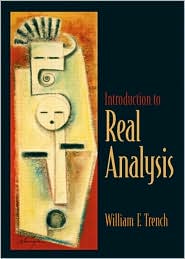
|
FreeComputerBooks.com
Links to Free Computer, Mathematics, Technical Books all over the World
|
|
- Title: Introduction to Real Analysis
- Author(s) William F. Trench
- Publisher: Prentice Hall (December 14, 2002); eBook (Creative Commons Licensed)
- License(s): CC BY-NC-SA 3.0
- Paperback: 574 pages
- eBook: PDF (587 pages)
- Language: English
- ISBN-10: 0130457868
- ISBN-13: 978-0130457868
- Share This:

|
Using an extremely clear and informal approach, this book introduces readers to a rigorous understanding of mathematical analysis and presents challenging math concepts as clearly as possible. The real number system. Differential calculus of functions of one variable. Riemann integral functions of one variable. Integral calculus of real-valued functions. Metric Spaces. For those who want to gain an understanding of mathematical analysis and challenging mathematical concepts.
The book is designed to fill the gaps left in the development of calculus as it is usually presented in an elementary course, and to provide the background required for insight into more advanced courses in pure and applied mathematics.
About the Authors- William F. Trench is Andrew G. Cowles Distinguished Professor (Retired) of Mathematiic, Trinity University.
- Calculus and Mathematical Analysis
- Algebra, Abstract Algebra (Groups, Rings, and Fields), and Linear Algebra, etc.

- Introduction to Real Analysis (William F. Trench)
- The Mirror Site (1) - PDF
- The Mirror Site (2) - HTML and PDF
-
 Elementary Real Analysis (Brian S. Thomson, et al)
Elementary Real Analysis (Brian S. Thomson, et al)
This book is written in a rigorous, yet reader friendly style with motivational and historical material that emphasizes the 'big picture' and makes proofs seem natural rather than mysterious.
-
 Measure, Integration and Real Analysis (Sheldon Axler)
Measure, Integration and Real Analysis (Sheldon Axler)
This textbook welcomes students into the fundamental theory of measure, integration, and real analysis. Focusing on an accessible approach, it lays the foundations for further study by promoting a deep understanding of key results.
-
 How We Got from There to Here: A Story of Real Analysis
How We Got from There to Here: A Story of Real Analysis
This book is an introductory real analysis textbook, presented through the lens of history. The definitions and techniques are motivated by the actual difficulties encountered by the intuitive approach and are presented in their historical context.
-
 Real Variables with Basic Metric Space Topology (Robert B. Ash)
Real Variables with Basic Metric Space Topology (Robert B. Ash)
Designed for a first course in real variables, this text presents the fundamentals for more advanced mathematical work, particularly in the areas of complex variables, measure theory, differential equations, functional analysis, and probability.
-
 Basic Real Analysis (Anthony W. Knapp)
Basic Real Analysis (Anthony W. Knapp)
This is a comprehensive treatment with a global view of the Real Analysis, emphasizing the connections between real analysis and other branches of mathematics. Included throughout are many examples and hundreds of problems.
-
 Interactive Real Analysis (Bert G. Wachsmuth)
Interactive Real Analysis (Bert G. Wachsmuth)
An interactive textbook for Real Analysis or Advanced Calculus in one real variable. It deals with sets, sequences, series, continuity, differentiability, integrability (Riemann and Lebesgue), topology, power series, and more.
-
 A Primer of Real Analysis (Dan Sloughter)
A Primer of Real Analysis (Dan Sloughter)
This is a short introduction to the fundamentals of real analysis, written the text assuming the reader has the level of mathematical maturity of one who has completed the standard sequence of calculus courses.
-
 An Introduction to Measure Theory (Terrence Tao)
An Introduction to Measure Theory (Terrence Tao)
This is a graduate text introducing the fundamentals of measure theory and integration theory, which is the foundation of modern real analysis, intended to cover a quarter or semester's worth of material for a first graduate course in real analysis.





